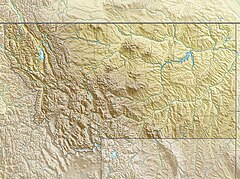Going-to-the-Sun Road
|
Going-to-the-Sun Road
|
|

East Side tunnel and Going-to-the-Sun Mountain
|
|
|
Location in Montana
|
|
| Location | Glacier National Park, Flathead / Glacier counties, Montana, USA |
|---|---|
| Nearest city | West Glacier, Montana |
| Coordinates | 48°41′42″N 113°49′01″W / 48.695°N 113.817°WCoordinates: 48°41′42″N 113°49′01″W / 48.695°N 113.817°W |
| Built | 1921-1932; dedicated 1933 |
| Architect | National Park Service; Bureau of Public Roads |
| NRHP Reference # | 83001070 |
| Significant dates | |
| Added to NRHP | June 16, 1983 |
| Designated NHL | February 18, 1997 |
Going-to-the-Sun Road is a scenic mountain road in the Rocky Mountains of the western United States, in Glacier National Park in Montana. The Sun Road, as it is sometimes abbreviated in National Park Service documents, is the only road that traverses the park crossing the Continental Divide through Logan Pass at an elevation of 6,646 feet (2,026 m), which is the highest point on the road. Construction began in 1921 and was completed in 1932 with formal dedication in the following summer on July 15, 1933. The road is the first to have been registered in all of the following categories: National Historic Place,National Historic Landmark and Historic Civil Engineering Landmark. The length of the road is approximately 50 miles (80 km) and spans the width of the park between the east and west entrance stations. The National Historic Landmark Nomination records a slightly shorter distance of 48.7 miles which is measured from the first main intersection just outside the park's west entrance to Divide Creek in St. Mary on the east side of the park.
The road is one of the most difficult roads in North America to snowplow in the spring. Up to 80 feet (24 m) of snow can lie on top of Logan Pass, and more just east of the pass where the deepest snowfield has long been referred to as the Big Drift. The road takes about ten weeks to plow, even with equipment that can move 4000 tons of snow in an hour. The snowplow crew can clear as little as 500 feet (150 m) of the road per day. On the east side of the continental divide, there are few guardrails due to heavy snows and the resultant late winter avalanches that have repeatedly destroyed every protective barrier ever constructed. The road is generally open from early June to mid October, with its late opening on July 13, 2011 marking the record for the latest opening since the inaugural date of July 15, 1933.
...
Wikipedia


